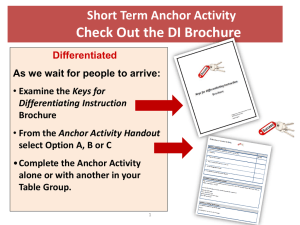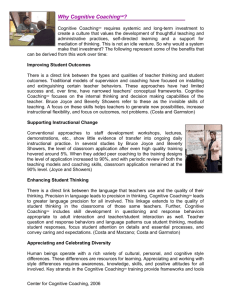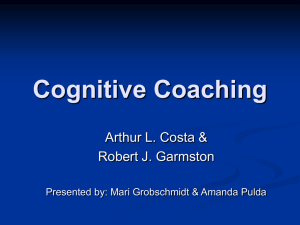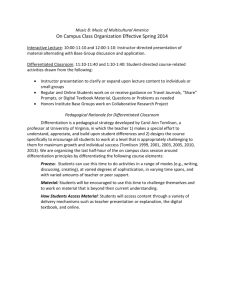File - Formative Assessment and Differentiated Instruction
advertisement
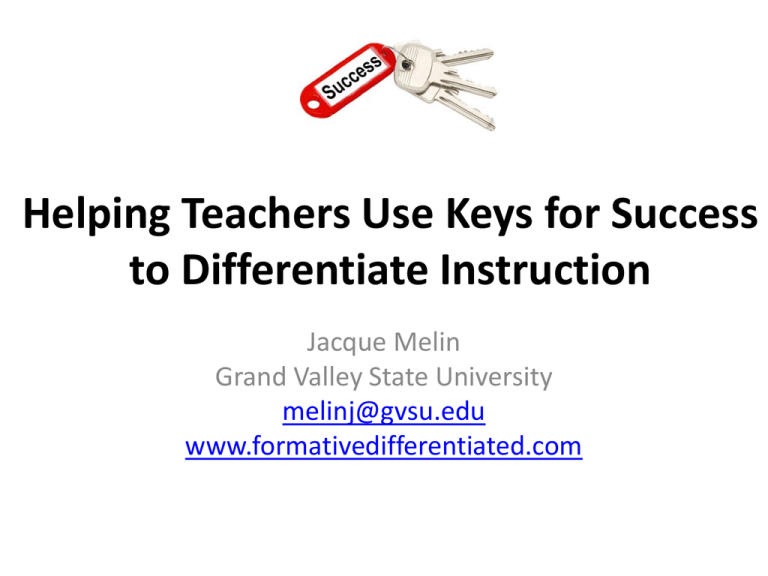
Helping Teachers Use Keys for Success to Differentiate Instruction Jacque Melin Grand Valley State University melinj@gvsu.edu www.formativedifferentiated.com Knowing the Learner – Pre-assessment • Take a few minutes to answer these questions anonymously. Short Term Anchor Activity Check Out the DI Brochure Differentiated • “AB Each Teach” the Keys for Differentiating Instruction Brochure • From the Anchor Activity Handout select Option A, B or C •Complete the Anchor Activity alone or with another in your Table Group. 3 A B Each Teach: Information Processing PROCESS • Pairs designate one partner as A and one as B. • Person A reads one section of text. • Person B reads another section of text. • When both are ready, they teach their section to their partner. (continue to do this – 2 pages at a time, until you finish the brochure, then work on the Short Anchor Activity) Mediated Journal …an advance organizer in which the page headings are predetermined or guided by the leader. Strategies Mediated Journal Name: Strategies Journal Entry 1 Pre-assessment A B Each Teach Short Anchor Activity Mediated Journal Journal Entry 2 Cover Inside Back 10:2 Rule Promise • Lecture: Processing Ratio • The brain needs to socially process Triple Track Agenda Track 1 = Using DI strategies to support your learning here in this room. Track 2 = How you might use DI strategies with adult groups and tips for sharing them with others. Track 3 = How you might use DI strategies with students in classrooms. Working Agreements • Standard #2: Learning Differences. The teacher uses understanding of individual differences and diverse cultures and communities to ensure inclusive learning environments that enable each learner to meet high standards • Standard #6: Assessment. The teacher understands and uses multiple methods of assessment to engage learners in their own growth, to monitor learner progress, and to guide the teacher’s and learner’s decision making. • Standard #7: Planning for Instruction. The teacher plans instruction that supports every student in meeting rigorous learning goals by drawing upon knowledge of content areas, curriculum, cross-disciplinary skills, and pedagogy, as well as knowledge of learners and the community context. • Standard #8: Instructional Strategies. The teacher understands and uses a variety of instructional strategies to encourage learners to develop deep understanding of content areas and their connections, and to build skills to apply knowledge in meaningful ways. • Standard #10: Leadership and Collaboration. The teacher seeks appropriate leadership roles and opportunities to take responsibility for student learning, to collaborate with learners, families, colleagues, other school professionals, and community members to ensure learner growth, and to advance the profession. Targets for this Workshop • I can establish or extend my understanding of differentiated instruction (Standards #2, 6, 7, 8). • I can articulate a vision with fellow teachers as to what is means to differentiate instruction for students in our schools (Standard #10) . – We must remember that excellent differentiated classrooms are excellent first and differentiated second. – Anonymous From Carol Tomlinson… FAQ How is differentiation different from “good teaching?” ANSWER There is no difference! Differentiation is just really good teaching! Targets for this Workshop • I can proactively plan instruction that is responsive to student differences (Standards #2, 6, 7, 8, 10). – Differentiated instruction is more anticipatory than reactive in nature. So really teachers should ask, “Am I planning for student differences or am I simply reacting to student failures?” -Taylor Ranch School’s Journey Towards Excellence From Carol Tomlinson… FAQ Isn’t differentiation something most teachers already do? ANSWER • Very few teachers proactively and robustly differentiate instruction. • That’s the standard necessary for academic diversity. Targets for this Workshop • I can coach my colleagues to help them use a variety of instructional strategies in order to effectively differentiate instruction (Standards #8, 10). – This seems simple enough, but surprisingly enough many educators are so determined to “get through” the curriculum that they neglect the more important challenge of “getting through” to the students. -Taylor Ranch School’s Journey Towards Excellence With the GOAL of… • Developing our collective identity and capacity as collaborators and inquirers (regarding DI) in order to increase learning for ALL students. From Adaptive Schools Garmston & Wellman Grounding (Small Fires) • Purpose – to set a norm for respectful listening, – to get everyone’s voice into the room, – to allow people to connect with one another, to allow for the expressions of hopes and apprehensions, – to value thinking and feeling, – and to elicit agendas that might not otherwise be heard. From Adaptive Schools Garmston & Wellman Grounding (Small Fires) • Procedure – Members take turns talking (I will give you the questions to talk about in just a minute). – When one member talks, all others are silent. Full nonverbal attention is given to the speaker. – After everyone has talked, the first speaker will summarize what was said. – What questions do you have about these directions? Grounding (Small Fires) • Topics – My name is . . . – My relationship to this topic (differentiated instruction) is . . . – My expectations are . . . – How I feel about being here is . . . Go VISUAL • 1st – Visual • 2nd – Kinesthetic • 3rd - Auditory From Adaptive Schools Garmston & Wellman Partners 1. Flexible Learning Groups 3. Respectful Tasks 2. Choice 4. Shared Responsibility for Learning Short Term Anchor Activity Debrief With your Flexible Learning Groups Partner… • Discuss: 1. how have the tasks so far been differentiated 2. what were the learning outcomes for each of the choices for the Anchor Activity 3. the option you selected and your reasons Long Term Anchor Tic Tac Toe • Identify nine activities related to learning targets. Make some of the activities more challenging than others. I like to set up the activities so that the more challenging are down the middle and across the middle. Basic More challenging Basic More challenging More challenging More challenging Basic More challenging Basic In this class we are never finished. Learning is a process that never ends.” - Carol Ann Tomlinson Long Term Anchor Tic Tac Toe Key Underlying Principles Knowledge of Students required to differentiate instruction: Readiness Interests Learning Profile (e.g., styles, intelligences, environmental 1. Knowing the Learner assessment for learning Aspects of the teaching/learning process that can be differentiated Content (learning materials) Process (how we help students learn) Product (how students demonstrate their learning) Learning Environment (conditions for learning) 2. Responding by Differentiating Assessment for Learning – Closed Sort On your own: • List (on paper) the many strategies that you have used or observed teachers using to differentiate instruction for students (e.g., extra time to complete a test, choice of questions, etc.) As a table group: • Share your strategies and write each strategy on a separate sticky note – have 2 recorders at your table and write each strategy twice (on sticky notes that are 2 different colors). Closed Sort Knowing the Students Using one set of sticky notes, sort the examples on your sticky notes by placing each note under one of the headings on a chart with these headings… INTEREST READINESS LEARNER PREFERENCES 26 Sort with the other set of sticky notes: Responding by Differentiating Using the other set of sticky notes, sort the strategies you have listed under each of these four headings on a new chart. CONTENT PROCESS PRODUCT LEARNING ENVIRONMENT 27 Closed Sort - Activity Debrief Discussion Questions – Table Group • Under which headings do we have the most/least ideas? • Why do we see the patterns we see here? • What might be some next steps suggested by the results of this sort? Stir the Classroom Today’s Standards Demand That We… Do…. • encourage students to understand what they are learning • apply and transfer what they learn. Do Not… • Have students memorize and repeat information Challenge of Today’s Standards • demand “deep” learning from more than just the “smart” or “advanced” kids. • require virtually ALL learners to think in complex and creative ways • students must be able to use what they learn in contexts beyond those practiced in class. Planning to “Teach Up” “Teaching up” is rooted in what Carol Dweck (2006) labels a “growth mindset” Teachers with growth mindsets believe that the brain is malleable and that the more we teach students as though they are smart, the more likely they are to become smart. Teaching Up… • means planning instruction for the broadest possible range of learners. • aiming high • then building scaffolding that helps all students reach those heights, including the students who may not have seen themselves as capable of making the climb. Teaching up… begins with the teacher asking… “What is the most thought-provoking, interesting, and engaging lesson(or unit) I can design to ensure that students will want to invest energy in complex questions, address significant issues, and master skills necessary for success with critical content?” Not “Harder” Curriculum, but More “Rigorous” “Hard” curriculum is taxing, burdensome, and demotivating; “Rigorous” curriculum is energizing, enlivening, and motivating. From Carol Tomlinson… FAQ Doesn’t differentiation lower expectations for students – “mollycoddle” them and cause them to be dependent? ANSWER • Defensible differentiation always “teaches up.” It’s never a way out of rigor – but rather a support to achieve rigor. It guides students in becoming independent. EFFECTS ON STUDENT ACHIEVEMENT OF SCHOOL AND TEACHER EFFECTIVENESS WITH STUDENT ENTERING SCHOOL AT THE 50th PERCENTILE 5th Grade Math Standardized Test Percentile Entering Average School Average Teacher 50th Highly Ineffective School Highly Ineffective Teacher 50th Highly Effective School Highly Ineffective Teacher 50th Highly Ineffective School Highly Effective Teacher 50th Highly Effective School Highly Effective Teacher 50th Highly Effective School Average Teacher 50th Achievement Percentile After Two Years 50th 3rd 37th 63rd 96th 78th Teachers were highly effective in instructional strategies, classroom management, and classroom curricular design. Marzano, Meta-analysis, 2001 Plan a 30 Second Speech What are some of your thoughts about Teaching Up? Tiered ThinkDots: Reflecting on Differentiation • Version A (1): You have some knowledge of the definition, vocabulary and principles of differentiation. • Version B (2): You are new to differentiation. Tiered ThinkDots: Reflecting on DI Journal 1 • What makes this a good activity? • What concerns do you have? • How might you use this activity in your classroom? Mediated Journal Strategies Pre-assessment A B Each Teach Short Anchor Activity Mediated Journal 10:2 Working Agreement Grounding (Small Fires) Go Visual Key Partners Long Term Anchor Closed Sort Stir the Classroom 30 Second Speech Tiered Think Dots Journaling Tiny events can disrupt a pattern. Key Features of a DI Classroom • Flexible grouping • Choice • Respectful tasks based on curriculum • Shared responsibility for learning 43 Spend a Buck PROCESS • Read the handouts about the Key Features: Flexible grouping, Choice, Respectful tasks based on curriculum, and Shared responsibility for learning • You have 100 imaginary pennies you can distribute among four options. • You decide how many pennies you will spend on each option (use up the entire dollar) – based on, from greatest to least, which you want to learn about more deeply. • I will explain what to do next. Looking for DI Before Viewing With your Choices Partner • Each select two key features to explore (so that you are observing for all 4 key features) Individually • Read about your key featurez: – Pages : KEY FEATURES 45 Video Segment During Viewing • Record evidence of your key features on the Looking for DI Handout After Viewing • Explain your key features to your partner and share your evidence SS/L-18ITEB 2010 Differentiated Instruction Summer Program View Videos First Grade Classroom Fifth Grade Classroom 47 Pack and Stack Salsa Line Up Strategies Jigsaw 1. 2. 3. 4. 5. Learning Menus as Anchor Activities RAFT and Trimind The Profiler and Show/Tell Structured Academic Controversy Tiering Strategies Jigsaw 1. With your “Expert Partner” – from another group, fill out the response chart for your strategy(ies). 2. “Experts” determine what ideas you will share and how you will share the ideas in your “Home Groups”. Strategies Jigsaw • Sharing in “Home Groups.” – Go in order – starting with #1. – Fill out your response chart as each “Expert” shares. – Appoint a timer – each “Expert” should devote 7-8 minutes to their strategy(ies). – Anchor Activity – work on one of these if you finish early. Tiering = Taking a solid, “baseline” assignment that has worked well in the past (for most students), and then trouble-shooting it to convert it into different versions (to connect to all students). Tiering is… A form of differentiation Differentiation according to readiness Based upon students’ readiness for a particular task Driven by preassessment NOT the only kind of differentiation, though it is foundational NOT locking students into “ability boxes” -groups are flexible and vary according to the task NOT more work or “better” work for some levels – tasks are equitable S H A P E Jacque Melin’s Differentiation Diner Mediated Journal Strategies Pre-assessment A B Each Teach Short Anchor Activity Mediated Journal 10:2 Working Agreement Grounding (Small Fires) Go Visual Key Partners Long Term Anchor Closed Sort Stir the Classroom 30 Second Speech Tiered Think Dots Journaling Strategies Spend a Buck Guided Viewing Pack and Stack Salsa Lineup Jigsaw Learning Menus RAFT Trimind Profiler Show and Tell Tiering Structured Academic Controversy From Carol Tomlinson… FAQ • Differentiation is too complicated. • It asks too much of teachers. Isn’t it unrealistic in its expectations? ANSWER • Teaching is complicated or at least high quality teaching is. • Differentiation doesn’t ask us to do everything at once, but it does ask us to work steadily toward understanding how we can use each classroom element separately and in an interrelated way to support student success. It asks us to grow in our craft. That ought to be quite reasonable. Tiny events can disrupt a pattern. Proactively Planning with Differentiation in Mind Think about learner variance that recurs from year to year, such as….. • weak readers, • students missing important prerequisite knowledge, • English language learners, • advanced learners, • students who approach learning in a variety of ways, • and students with weak academic vocabularies. Proactively Planning with Differentiation in Mind Plan with the Key Features of Differentiation in mind…. • Flexible grouping (F) • Choice (C) • Respectful tasks based on curriculum (R) • Shared responsibility for learning (S) Model: What would I do… Besides paying attention to F,C,R,S • Use Scaffolding – Create an environment where students bump into success – – – – – Help students set, monitor, and adjust goals Offer multiple modes of activities or assessments Providing graphic organizers or templates Ensure planned opportunities for needed practice Provide advanced students with another opportunity to express their knowledge/skills – Use small-group instruction to provide targeted instruction or practice – Use technology to support student reading, writing, speaking, hearing, or movement – Use peer brainstorming groups to prime thinking and planning What would I do… Paying attention to F,C,R,S Work with your Shared Responsibility for Student Learning Partner We want to Increase Student Learning In order to do this…..how Adaptive are we? Adaptive Definition: Changing form (practice) while changing identity. Focusing Questions: Who are we? Who do we need to be? Why are we doing this? Why are we doing this this way? From Adaptive Schools Garmston & Wellman Adapted or Adaptive? Companies that are adaptive…(or not) • Adaptive • Not • Target • Blockbuster • Google • Sears • 3M • Amazon • Apple Apple Dilts Nested Levels of Learning One level impacts the other… Identity Beliefs, Values, Assumptions Capabilities Behaviors Environment WHO? WHY? HOW? WHAT? WHERE? “All the good work in schools is just tinkering unless we clarify our identities as collaborators and inquirers.” - Michael Fullan Vision for School Change The Elements of Professional Community 1. Compelling purpose and academic focus 4. Deprivatized practice 2. Collective efficacy and shared responsibility for student learning 5. Relational trust in one another 3. Collaborative culture 6. Individual and group learning based on ongoing assessment and feedback From Adaptive Schools Garmston & Wellman Collaboration Collaboration does not happen by chance; it has to be taught, practiced and learned. Developing collaborative cultures is the work of leaders who realize that a collection of superstar teachers working in isolation cannot produce the same results as interdependent colleagues who share and develop professional practices together. - Garmston and Wellman Outcomes for this part of the workshop • Gain an emerging understanding of the benefits of Cognitive Coaching℠ • Examine skills needed to be a proficient collaborator • Explore a communication tool that supports collaboration From Cognitive Coaching ℠ Costa and Garmston Model • List what you observe about: – The interaction – The coach’s behavior – The coachee’s thinking From Cognitive Coaching ℠ Costa and Garmston Mission Statement • The mission of Cognitive Coaching℠ is to produce selfdirected persons with the cognitive capacity for high performance both independently and as members of a learning community. • The metaphor of a stagecoach is one used to understand what a coach does—convey a valued person from where s/he is to where s/he wants to be. From Cognitive Coaching ℠ Costa and Garmston How Proficient Collaborators Think and Act • Which of these strategies do you use? Does your staff use? • Which of these strategies might need to be modeled and practiced to encourage students/adults to use? From Cognitive Coaching ℠ Costa and Garmston Positive Presuppositions • “Given our shared • Instead of asking, concern about student “Does any body here achievement, let’s know why the kids examine our aren’t learning? assumptions about what might be causing the gaps in learning.” From Cognitive Coaching ℠ Costa and Garmston Positive Presuppositions • • • • • As you reflect upon the lesson, As you examine the data, Based upon past successful experiences, As an experienced educator, As a successful teacher, From Cognitive Coaching ℠ Costa and Garmston Pausing • Wait time. From Cognitive Coaching ℠ Costa and Garmston Paraphrasing/Listening Set Asides Paraphrasing Listening Set Asides • Attend fully • Capture the essence of the message • Paraphrase before asking a question • Use the pronoun “you” instead of “I”. • Autobiographical • Inquisitive • Solution From Cognitive Coaching ℠ Costa and Garmston Principals of Paraphrasing Paraphrasing sends three messages 1. I am listening 2. I am interested/I care 3. I understand you (or I am trying to) From Cognitive Coaching ℠ Costa and Garmston Planning Conversation • Occurs before a colleague conducts or participates in an event, resolves a challenge, or attempts a task. The coach may or may not be present during the event or available for follow-up conversation. You try (with your Flexible Groupings Partner)… Other Resources • Strategies for Struggling Readers: • http://www.peterpappas.com/blogs/read-blog/nonreader-complete.pdf • Websites and Apps that Support DI • http://www.sde.ct.gov/sde/lib/sde/pdf/curriculum/cali /di_websites_chart.pdf • Inclusion Activities, Group Processing Activities, etc. • https://rowman.com/WebDocs/CD%204x6%20Cards.p df Journal 2 • Armed with all of the information from this workshop, what are YOUR next steps?
